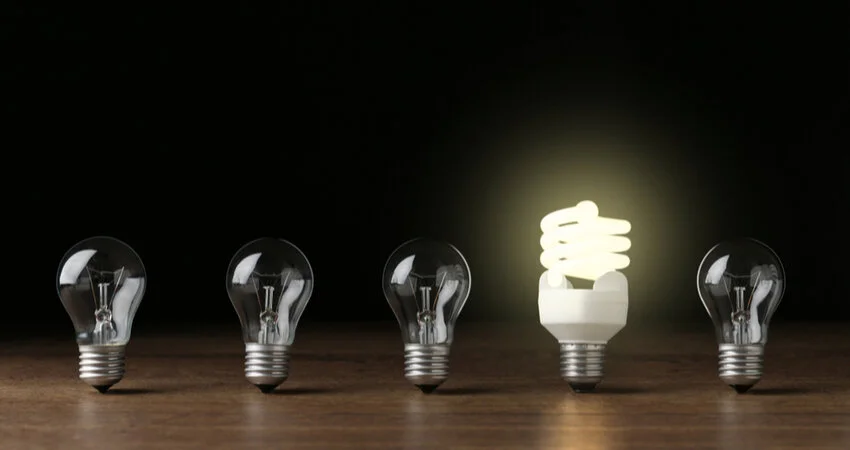Quiz: Test Your Home Energy IQ
Test your knowledge in our Home Energy Quiz! Make sure to check your answers at the end and pick up some energy-saving tips.
Take the Quiz:
1. How much energy usage in your home is contributed to heating and cooling?
a. 2/3
b. 1/2
c. 1/3
2. If heating and cooling together make up the highest energy usage in your home, what do you think is the second-largest energy usage?
a. Appliances and electronics
b. Water heating
c. Lighting
3. How often should you change the air filters in your HVAC system?
a. About twice a year
b. Whenever I think about it
c. At least four times a year
4. When is the best time to use a ceiling fan?
a. Ceiling fans help save energy and keep you comfortable in both winter and summer
b. Ceiling fans work best in summer when it's hot outside
c. In winter when warm air needs to circulate in the house
5. What initial step should you take to help reduce energy costs around the house?
a. Locate and seal updrafts around doors, windows, baseboards with caulk or weather stripping
b. Add insulation to the attic and basement, such as open wall tops and ducts
c. Turn off the heating and air conditioning system when you're away
6. Which uses less energy, Stove or microwave?
a. Microwave
b. Stove
7. How much less energy do LEDs use compared to traditional incandescent bulbs?
a. 50%
b. 80%
c. 10%
Let’s see how you did!
Answers:
1. b- ½
As your main source of comfort from extreme outdoor temperatures, your HVAC system uses the most energy of any single appliance or system at 46 percent of the average U.S. home's energy consumption. An average central HVAC unit uses about 3500 watts and runs two to three times an hour for 10-15 minutes. In a 24-hour period, your HVAC would use around 28-63 kWh, resulting in about 850-1,950 kWh in a month, depending on the efficiency of your unit.
2. b- Water Heating
Top ways to cut water heating bills include turning down the thermostat on your water heater (120 degrees is ideal), insulating your water heater and pipes, and investing in a new, more efficient model.
3. c- At least four times a year
The U.S. Department of Energy recommends you change it at least every three months; or more often during heavy-use periods. A dirty filter can slow down airflow, which forces your HVAC system to work harder to keep your home hot or cold.
4. a- Ceiling fans help save energy and keep you comfortable in both winter and summer
Ceiling fans improve comfort in both winter and summer. During winter, run them clockwise (upward motion) at a low speed to circulate heat that gathers near the ceiling. In summer or hot climates, run them counterclockwise (or downward) to cool. Most fans have a switch to reverse the spin. When cooling, always turn off your ceiling fan when you leave the room, just as you do your lights (a fan only cools you, not a room, by creating a "wind-chill effect").
5. a- Locate and seal updrafts around doors, windows, baseboards with caulk or weather stripping
Sealing up your home is one of the most cost-effective ways to improve your home's comfort and reduce energy costs. Hidden gaps and cracks in a home can add up to as much airflow as an open window and cause your heating and cooling system to work harder, use more energy, and cost more. Seal these leaks with caulk, spray foam, and weather stripping.
6. a- Microwave
Efficient microwaves can use from 40-80% less energy than conventional ovens, depending on the make and, of course, the age of your oven. Bonus? In warm weather, a microwave won't heat up your kitchen.
7. b- 80%
By replacing your home's five most frequently used light fixtures or bulbs with models that have earned the ENERGY STAR, you can save $75 each year. Compared to traditional incandescents, energy-efficient lightbulbs such as halogen incandescents, compact fluorescent lamps (CFLs), and light-emitting diodes (LEDs) have the following advantages:
Typically use about 25%-80% less energy than traditional incandescents, saving you money
Can last 3-25 times longer.
Today's energy-efficient bulbs are available in the wide range of colors and light levels you've come to expect. While the initial price of energy-efficient bulbs is typically higher than traditional incandescents, newer bulbs cost less to operate, saving you money over the life of the bulb. Many of the newer bulbs last significantly longer than traditional bulbs, so you won't need to replace them as often.





